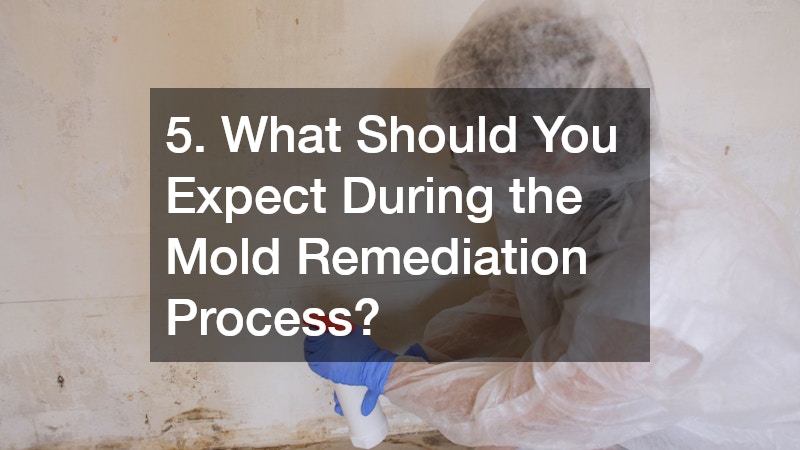Mold is a common but serious issue that can affect both the health of individuals and the integrity of structures. Professional mold remediation services play a crucial role in effectively addressing and preventing mold problems, ensuring that both your health and property are protected.
1. What are the Health Risks Associated with Mold Exposure?
1.1 Respiratory Issues and Allergies
Mold spores can become airborne and are easily inhaled, leading to respiratory issues and allergic reactions. Individuals with pre-existing respiratory conditions, such as asthma, can experience worsened symptoms due to mold exposure.
Even in those without pre-existing allergies, mold exposure can lead to the development of new sensitivities. This highlights the need for timely intervention to minimize health risks.
Frequent exposure to mold can progressively increase sensitivity, resulting in chronic respiratory problems. Therefore, controlling mold growth is essential for maintaining healthy indoor air quality.
1.2 Mold-Induced Illnesses
Prolonged mold exposure can lead to illnesses beyond mere allergies, including infections and toxic effects. Certain molds produce mycotoxins, which have been linked to serious health issues such as memory loss and pulmonary hemorrhage.
It is important to understand that mold-induced illnesses can vary significantly among individuals. However, the potential for severe health impacts makes professional mold removal a priority.
While not all molds are dangerous, those that are can cause significant health problems if left untreated. Professional remediation can help mitigate these risks quickly and efficiently.
2. How Can You Identify Mold Growth at Home?
2.1 Common Signs of Mold Infestation
Mold growth is often accompanied by visible discoloration on surfaces, like black, green, or even white patches. Accompanying these signs is often a distinct musty odor, indicative of mold presence.
While some instances of mold growth are visible, these signs are not always obvious. Observing changes in smell or feeling unwell in a particular area can indicate unseen mold issues.
The importance of early identification of mold cannot be overstated, as taking action quickly can minimize health risks and property damage. Professionals can more accurately diagnose the extent of mold growth through their expertise.
2.2 Hidden Mold Concerns
Mold often grows in hidden spaces, such as behind walls, under carpets, or inside ductwork, making it challenging to recognize for the untrained eye. Improper identification can result in the problem worsening, causing more extensive damage.
Professional mold inspection tools can detect these obscured infestation zones effectively. Taking advantage of these services ensures that all mold growth areas are identified and treated appropriately.
Not all mold problems exhibit visible signs, making the role of professional mold services invaluable. Utilizing their skills and equipment, professionals ensure a thorough check and remediation process.
3. Why Are Professional Mold Remediation Services Essential?
3.1 Expert Assessment and Tools
Professional mold remediation services offer expert assessments that accurately determine the extent of mold issues. With specialized equipment like humidity detectors and infrared cameras, professionals can identify both visible and hidden mold sources.
These tools allow for a comprehensive evaluation, providing a solid foundation for an effective remediation plan. This science-backed approach results in more efficient, complete mold removal.
Besides assessment, experts have access to industrial-grade solutions and equipment to eradicate mold entirely. This efficiency in service delivery minimizes future risks of mold reappearing.
3.2 Prevention of Recurrence
One of the primary benefits of hiring professionals is the implementation of preventive measures against mold regrowth. Professionals apply mold-resistant treatments on susceptible surfaces to prevent future infestations.
Remediation experts not only get rid of existing mold but also address the underlying moisture issues that facilitate mold growth. This dual approach significantly reduces the likelihood of mold returning.
Regular inspections and maintenance suggested by professionals can keep homes mold-free. Such preventive action plays an important role in safeguarding health in the long term and prolonging the life of building materials.
4. What are the Cost Implications of Mold Remediation?
4.1 Cost Factors in Mold Remediation
Several factors influence the cost of mold remediation, including the extent of infestation and remediation techniques. More extensive damage or particular molds may require more in-depth treatment, influencing the total cost.
The type of mold and where it is located can also add to costs, especially if structural repairs are needed. However, understanding these factors allows homeowners to budget accordingly and weigh their options.
Despite costs, professional remediation offers lasting value by preventing future mold issues. Investing in professional services initially can save money on future repair and health costs.
4.2 Weighing Cost Against Health and Property Damage
While at first seemingly costly, mold remediation can be cost-effective when considering long-term health and property savings. Addressing mold early can prevent more significant damage to building structures and long-term health issues.
Conversely, ignoring or inadequately treating mold leads to higher costs down the line through structural repairs or healthcare expenses. Thus, the financial benefits of choosing professional services outweigh initial costs.
Investing in professional mold remediation not only restores property integrity but also ensures a safer living environment. Consequently, spending now can save more significant financial burdens in the future.
5. What Should You Expect During the Mold Remediation Process?
5.1 Step-By-Step Process
The mold remediation process typically begins with a thorough inspection to assess the extent and source of the mold. Once identified, containment measures are put in place to prevent mold from spreading.
Professional removal follows, utilizing safe and effective methods to eliminate mold. Cleaning and restoration of affected areas wrap up the process, ensuring spaces are mold-free and safe.
5.2 Post-Remediation Inspection and Guarantees
Post-remediation inspections are crucial to confirm that the mold has been successfully removed and that no new growth is occurring. Many professional services offer guarantees as part of their remediation package.
These guarantees provide confidence that the problem has been resolved, and should the mold reappear within a specified period, it may be addressed without additional costs. Customers are encouraged to inquire about available warranties when selecting a service provider.

